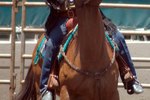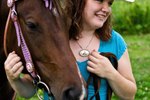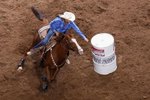Staying in place.
The bridle is held in place on the horse's head by the cheekpieces, which run down the sides of the horse's face, the headstall, which goes over the top of the horse's head and sits behind the ears, and the throatlatch, which goes under the horse's head from the right ear to the left. The browband runs across the horse's forehead and sits just below the ears.
The bit.
The bit goes into the horse's mouth, and always sits on top of the tongue. (A bit that has slipped under the horse's tongue has none of the desired ability for control.) Horses have a space in their teeth, called 'the bars' where the bit rests.This makes it easier to hold the bit in place, where it acts on principles of leverage to allow the rider to control the horse's movement. Improperly fitted or used bits can cause a horse considerable pain. Some bits, called snaffles, act by using pressure on the horse's tongue.
The rider's touch.
The reins run from the bit, and usually reach well past the horse's withers. They allow the rider to control the horse's directional and forward movement, supplemented by signals from the rider's legs.
Signals.
Horses can be trained to response to a rider in a number of ways, but generally putting pressure on one of the reins will pull the horse's head in the direction the rider wants to go.
Bitless bridles.
There are also some bridles that don't have a bit. These bridles have a nosepiece that is used to control the horse, putting pressure on different points of the animal's face instead of on the mouth.
Fitting a bridle.
The leather pieces of the bridle - the cheekpieces, browband, headstall and throatlatch can all be adjusted to fit the horse. A bridle that is too loose can rub the horse and create sore spots, while a loose bridle can easily come off. Cheekpieces allow the bit to sit in the proper place in the horse's mouth. The bit must also be fitted for the horse, as one that is too long or too narrow can cause the horse discomfort.





